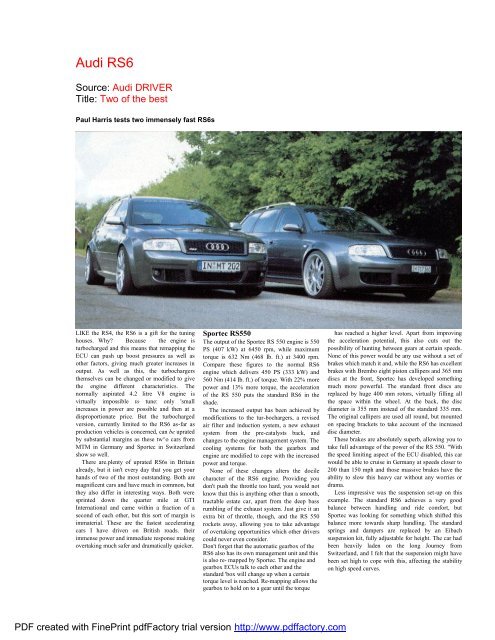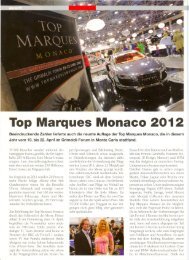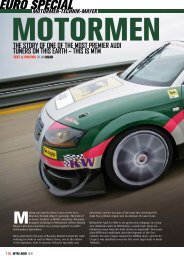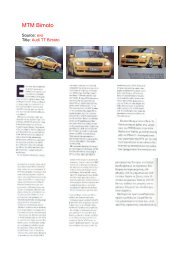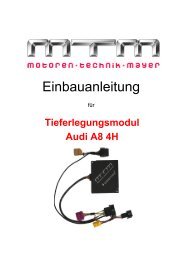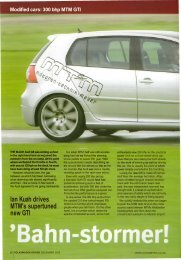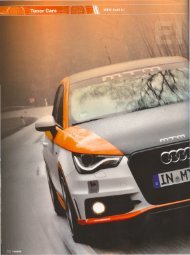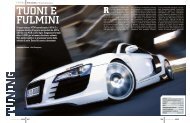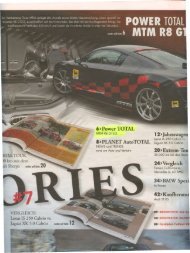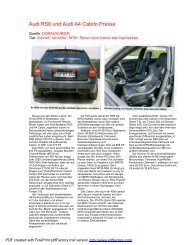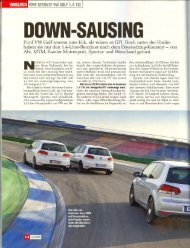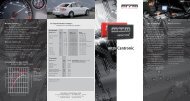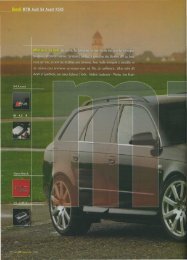Audi RS6 - MTM
Audi RS6 - MTM
Audi RS6 - MTM
You also want an ePaper? Increase the reach of your titles
YUMPU automatically turns print PDFs into web optimized ePapers that Google loves.
<strong>Audi</strong> <strong>RS6</strong><br />
Source: <strong>Audi</strong> DRIVER<br />
Title: Two of the best<br />
Paul Harris tests two immensely fast <strong>RS6</strong>s<br />
LIKE the RS4, the <strong>RS6</strong> is a gift for the tuning<br />
houses. Why? Because the engine is<br />
turbocharged and this means that remapping the<br />
ECU can push up boost pressures as well as<br />
other factors, giving much greater increases in<br />
output. As well as this, the turbochargers<br />
themselves can be changed or modified to give<br />
the engine different characteristics. The<br />
normally aspirated 4.2 litre V8 engine is<br />
virtually impossible to tune: only 'small<br />
increases in power are possible and then at a<br />
disproportionate price. But the turbocharged<br />
version, currently limited to the <strong>RS6</strong> as-far as<br />
production vehicles is concerned, can be uprated<br />
by substantial margins as these tw^o cars from<br />
<strong>MTM</strong> in Germany and Sportec in Switzerland<br />
show so well.<br />
There are.plenty of uprated <strong>RS6</strong>s in Britain<br />
already, but it isn't every day that you get your<br />
hands of two of the most outstanding. Both are<br />
magnificent cars and have much in common, but<br />
they also differ in interesting ways. Both were<br />
sprinted down the quarter mile at GTI<br />
International and came within a fraction of a<br />
second of each other, but this sort of margin is<br />
immaterial. These are the fastest accelerating<br />
cars I have driven on British roads. their<br />
immense power and immediate response making<br />
overtaking much safer and dramatically quicker.<br />
Sportec RS550<br />
The output of the Sportec RS 550 engine is 550<br />
PS (407 kW) at 6450 rpm, while maximum<br />
torque is 632 Nm (468 Ib. ft.) at 3400 rpm.<br />
Compare these figures to the normal <strong>RS6</strong><br />
engine which delivers 450 PS (333 kW) and<br />
560 Nm (414 Ib. ft.) of torque. With 22% more<br />
power and 13% more torque, the acceleration<br />
of the RS 550 puts the standard <strong>RS6</strong> in the<br />
shade.<br />
The increased output has been achieved by<br />
modifications to the tur-bochargers, a revised<br />
air filter and induction system, a new exhaust<br />
system from the pre-catalysts back, and<br />
changes to the engine management system. The<br />
cooling systems for both the gearbox and<br />
engine are modified to cope with the increased<br />
power and torque.<br />
None of these changes alters the docile<br />
character of the <strong>RS6</strong> engine. Providing you<br />
don't push the throttle too hard, you would not<br />
know that this is anything other than a smooth,<br />
tractable estate car, apart from the deep bass<br />
rumbling of the exhaust system. Just give it an<br />
extra bit of throttle, though, and the RS 550<br />
rockets away, allowing you to take advantage<br />
of overtaking opportunities which other drivers<br />
could never even consider.<br />
Don't forget that the automatic gearbox of the<br />
<strong>RS6</strong> also has its own management unit and this<br />
is also re- mapped by Sportec. The engine and<br />
gearbox ECUs talk to each other and the<br />
standard 'box will change up when a certain<br />
torque level is reached. Re-mapping allows the<br />
gearbox to hold on to a gear until the torque<br />
PDF created with FinePrint pdfFactory trial version http://www.pdffactory.com<br />
has reached a higher level. Apart from improving<br />
the acceleration potential, this also cuts out the<br />
possibility of hunting between gears at certain speeds.<br />
None of this power would be any use without a set of<br />
brakes which match it and, while the <strong>RS6</strong> has excellent<br />
brakes with Brembo eight piston callipers and 365 mm<br />
discs at the front, Sportec has developed something<br />
much more powerful. The standard front discs are<br />
replaced by huge 400 mm rotors, virtually filling all<br />
the space within the wheel. At the back, the disc<br />
diameter is 355 mm instead of the standard 335 mm.<br />
The original callipers are used all round, but mounted<br />
on spacing brackets to take account of the increased<br />
disc diameter.<br />
These brakes are absolutely superb, allowing you to<br />
take full advantage of the power of the RS 550. "With<br />
the speed limiting aspect of the ECU disabled, this car<br />
would be able to cruise in Germany at speeds closer to<br />
200 than 150 mph and those massive brakes have the<br />
ability to slow this heavy car without any worries or<br />
drama.<br />
Less impressive was the suspension set-up on this<br />
example. The standard <strong>RS6</strong> achieves a very good<br />
balance between handling and ride comfort, but<br />
Sportec was looking for something which shifted this<br />
balance more towards sharp handling. The standard<br />
springs and dampers are replaced by an Eibach<br />
suspension kit, fully adjustable for height. The car had<br />
been heavily laden on the long Journey from<br />
Switzerland, and I felt that the suspension might have<br />
been set high to cope with this, affecting the stability<br />
on high speed curves.
The standard <strong>RS6</strong> has a feature which <strong>Audi</strong><br />
calls DRC, for dynamic ride control. The<br />
diagonally opposite dampers are connected by<br />
hydraulic lines incorporating valves and the<br />
nett result is that pitching and rolling are<br />
reduced when the suspension on one side of the<br />
car is being compressed. On the Sportec car,<br />
this system had been disconnected because of<br />
the replacement of the original dampers and I<br />
suspect it would have felt more stable on fast<br />
bends if it had still been operational.<br />
The Sportec wheels on the RS 550 have a<br />
diameter of 20-inches and are remarkably light<br />
one-piece forgings. Each weighs only 11.5 kg,<br />
contributing to a very significant reduction in<br />
unsprung weight and improvement in<br />
roadholding. The Continental Conti Sport 2<br />
tyres had a 255/30 section.<br />
This car had some interesting cosmetic<br />
alterations, including a rear skirt made from<br />
carbon fibre and shaped to accept the four tail<br />
pipes and, inside the cabin, aluminium pedals<br />
and foot rest, together with carbon-fibre gearchange<br />
paddles, plus and minus clearly<br />
embossed on their surfaces.<br />
Both of these <strong>RS6</strong>s are fabulous cars, with<br />
acceleration beyond anything one can<br />
experience with any other conventional road car.<br />
They both demonstrate that this sort of<br />
performance can be achieved without any loss<br />
of smoothness or flexibility. None of these<br />
modifications are cheap, but then we are talking<br />
about a car which starts off at close to .£60,000.<br />
One thing is very clear. Both of these cars have<br />
all the versatility of other A6 Avants, practical<br />
and capable of carrying big loads, and no other<br />
car can come near them in terms of practicality<br />
and hyper-performance.<br />
<strong>RS6</strong>-<strong>MTM</strong><br />
The output of the <strong>MTM</strong> modified <strong>RS6</strong> engine<br />
is rated at 535 PS (393 kW), a little lower than<br />
that of the Sportec RS 550, but, at this level,<br />
the difference is not very significant. This<br />
Stage 3 conversion involves replacing the<br />
down pipes from the exhaust manifolds, a job<br />
which involves removal of the engine and so<br />
the labour cost is quite high. Perhaps more<br />
significantly, the maximum torque is 720 Nm<br />
(533 Ib.ft.) at 3160 rpm, while the power peaks<br />
at ^SSO rpm. The power of the standard <strong>RS6</strong><br />
engine is achieved at 5700 rpm and then<br />
remains level before falling away at 6400 rpm.<br />
<strong>MTM</strong> uses a complex exhaust system which<br />
does away with the primary catalytic<br />
converters and replaces the main converters<br />
with 100 cell units. Like the RS 550<br />
conversion, it ends with four pipes, but the<br />
outer pair incorporate vacuum controlled flap<br />
valves, a system which <strong>Audi</strong> already uses for<br />
the TT 3.2. At normal throttle openings, the<br />
flap valves remain closed and the exhaust<br />
sound is quite muffled but, when the<br />
accelerator pedal is opened enough to increase<br />
the boost pressure, the vacuum unit opens the<br />
valves. The result is a magnificent crackle,<br />
almost like that of a vintage formula racing car,<br />
as the car accelerates away. As soon as the<br />
boost drops, the flap valves close to reduce the<br />
sound level and, when the engine is switched<br />
off, they open to relieve any pressure in the<br />
system.<br />
Fuel consumption? With either car, reckon<br />
on an average of around 18-19 mpg on British<br />
roads, using plenty of opportunity to exercise<br />
the engine's potential. Higher cruising speeds<br />
and greater use of the acceleration will knock it<br />
back to about 16 mpg hut, on the other hand,<br />
driving it quietly can return just over 20 mpg.<br />
Both cars need 98 octane petrol so, in this<br />
country, you will need to seek out Shell<br />
stations to fill up with Optimax.<br />
Bear one important point in mind. The <strong>RS6</strong> is a<br />
very heavy car, weighing in at 4112 Ib.<br />
PDF created with FinePrint pdfFactory trial version http://www.pdffactory.com<br />
Much of the improvement in output comes from remapping<br />
the engine ECU, permitting a maximum<br />
boost pressure of 2.31 bar. The gearbox ECU is also<br />
re-mapped to prevent hunting between gears at certain<br />
speeds.<br />
Unlike the Swiss car, the suspension of the <strong>MTM</strong><br />
<strong>RS6</strong> was completely standard. Although this might not<br />
be the ideal set-up for competition, it provides a<br />
comfortable ride and considerable stability in curves.<br />
<strong>Audi</strong>'s DRC system certainly works well and the<br />
<strong>MTM</strong> car shows that the standard suspension is ideal<br />
for road use, even when the power is boosted to such a<br />
high level.<br />
The <strong>MTM</strong> brake conversion is less radical, the front<br />
discs increased in diameter to 380 mm, again in con-<br />
junction with the standard 8-piston Brembo callipers.<br />
Although this set-up may not match the 400/355<br />
combination at very high speeds, I found that it could<br />
cope powerfully with any braking conditions likely to<br />
be met on the road. Kim Collins at qst, the British<br />
importer for <strong>MTM</strong>, considers that the Mov' It brake<br />
conversion is superior. This has 380 mm front discs,<br />
with 6 rather than 8-piston callipers, but the 6 gives a<br />
greater pad area. Mov' It also has a 342 mm rear brake<br />
set-up with 4-piston callipers and separate handbrake<br />
callipers.<br />
The wheels, 9.5 x 19-inches, are unique to <strong>MTM</strong><br />
and, on the test car, were shod with 275/30 Pirelli P<br />
tyres.<br />
unladen. Modest increases in power will have little<br />
effect on its acceleration and it is only by increasing<br />
the output by big margins that the tuners are able to<br />
make significant improvements to its performance.<br />
Both of these cars will accelerate from rest to 60 mph<br />
in less than 4.5 seconds, and ungoverned, will<br />
probably achieve close to 200 mph, should the<br />
conditions ever permit.<br />
Both <strong>MTM</strong> and Sportec have agents with excellent<br />
reputations in this country. <strong>MTM</strong> is handled by Kim<br />
Collins qst in Sussex, while Sportec is imported by<br />
AmD in Bicester. II
PDF created with FinePrint pdfFactory trial version http://www.pdffactory.com
PDF created with FinePrint pdfFactory trial version http://www.pdffactory.com


